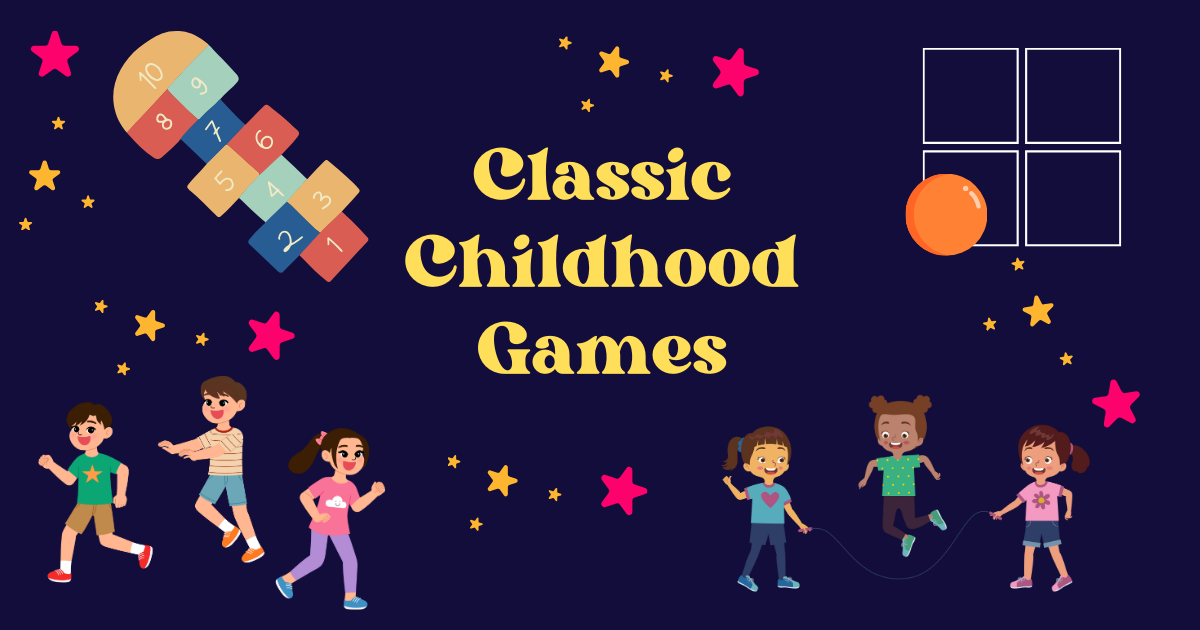Do you remember what recess was like when you were a kid? The bell would ring, and in seconds the playground was alive with kickball games, chalked hopscotch grids, jump rope rhymes, and the ever-competitive four square court. For many of us who grew up in the ’80s and ’90s, recess wasn’t just a break from schoolwork—it was the highlight of the day.
Today, kids’ free time looks a lot different. Screens, structured extracurriculars, and busy schedules often take the place of unstructured outdoor play. But here’s the thing: those classic playground games we grew up with aren’t just fun—they’re also fantastic for learning, social skills, and physical activity. And if you’re homeschooling, you have the perfect opportunity to bring some of that recess magic back.
Let’s take a trip down memory lane and rediscover the games that made our childhood recess so special—and how you can easily reintroduce them into your homeschool routine.
Kickball: The King of the Playground
If there was one game that could unite an entire playground, it was kickball. The rules were simple: a big rubber ball, four bases, and lots of excitement. Whether you were the star kicker sending the ball flying or the kid praying you wouldn’t get tagged out, everyone found a place on the kickball field.
Kickball wasn’t just about exercise—it taught teamwork, strategy, and good old-fashioned sportsmanship. And best of all, it required almost no equipment.
How to Bring It Back:
- All you need is a rubber ball and a bit of outdoor space (backyard, park, or even a quiet street).
- Create simple rules and keep the teams small if you have fewer players.
- For homeschool groups, kickball makes a perfect activity for co-ops or playdates.

Four Square: Fast, Fun, and Competitive
Do you remember the painted square on the blacktop where recess legends were made? Four square was the ultimate test of quick reflexes, hand-eye coordination, and, let’s be honest, a little playground drama. Players rotated through the four squares, aiming to defend their spot as “king” while bouncing the ball strategically to eliminate others.
It was fast-paced, competitive, and incredibly addictive. Four square taught kids how to think on their feet, adapt quickly, and accept the occasional “you’re out!” with a smile (or maybe a little protest).
How to Bring It Back:
- Use chalk or tape to create a four-square grid on your driveway, patio, or sidewalk.
- A playground ball or rubber ball works perfectly.
- Teach kids a few variations of the game to keep things fresh.
Hopscotch: Jumping Through Numbers and Fun
Few sights are as nostalgic as a hopscotch board drawn in chalk across the blacktop. With nothing more than a handful of chalk and a small stone, kids could entertain themselves for hours.
Hopscotch wasn’t just fun—it built balance, coordination, and counting skills without kids even realizing it. Jumping from square to square while trying not to step on the lines was a challenge that never got old.
How to Bring It Back:
- Draw a hopscotch board in your driveway or on the sidewalk with chalk.
- Use small toys, coins, or stones as markers.
- For variety, create themed boards with letters, shapes, or even sight words for younger learners.
Jump Rope Rhymes: Sing, Skip, Repeat
“Cinderella, dressed in yellow,
Went upstairs to kiss her fellow,
Made a mistake and kissed a snake,
How many doctors will it take? 1…2…3…”
If you just caught yourself chanting along, you know the magic of jump rope rhymes. These weren’t just silly songs—they were a blend of rhythm, laughter, and playful competition. The goal was simple: keep the rhyme going as long as you could without tripping on the rope.
Jump rope was never just about exercise. It was about memory (trying to keep up with the verses), creativity (kids constantly invented new rhymes), and pure joy. Whether you were solo jumping, double-dutching with friends, or daring to leap into a spinning long rope, the energy was contagious.
Why Classic Recess Games Still Matter Today
It’s tempting to think of these games as “just for fun,” but they actually carry powerful benefits for kids—especially in a homeschool environment where physical activity and social learning can look different from traditional school.
Here’s why bringing back these games is worth it:
- Exercise without pressure – Running, jumping, and skipping keeps kids active in a way that feels like play, not PE.
- Social skills – Even with siblings or neighborhood kids, games like kickball and four square teach teamwork, fairness, and conflict resolution.
- Brain breaks – Short bursts of movement help kids return to lessons focused and refreshed.
- Motor skills – Jump rope and hopscotch build coordination, balance, and rhythm.
- Memory and creativity – Rhymes and chants exercise memory while sparking creativity.
Other Playground Favorites Worth Revisiting
While kickball, four square, hopscotch, and jump rope were big stars, recess had plenty of other gems. Do you remember these?
- Red Rover – A test of strength and strategy (though maybe a little rough at times).
- Tug of War – A classic game where two teams compete by pulling opposite ends of a rope, testing their strength to see which side prevails.
- Freeze Tag – A playground classic that got everyone running.
- Marbles – Small but mighty, marbles encouraged patience and precision.
- Chalk Art – Not exactly a game, but entire sidewalks became colorful masterpieces.
- Wall Ball – A simple ball, a wall, and endless variations of rules created hours of fun.
These games required almost nothing in terms of supplies—just imagination, a ball, and maybe a stick of chalk. That’s what made them so magical.
How to Incorporate Classic Recess Games into Homeschool
As homeschool parents, we have the freedom to shape our kids’ days—and that includes making space for recess, even if there’s no official bell to signal it.
Here are some simple ideas to bring recess nostalgia into your homeschool routine:
- Schedule recess breaks – Build short outdoor play sessions between subjects.
- Make it family time – Play kickball or hopscotch together for bonding and exercise.
- Use it as a group activity – Invite other homeschool families to join in for co-op recess days.
- Tie in learning – Use chalk games to practice math facts, spelling words, or even geography by turning hopscotch squares into “countries.”
- Let kids lead – Encourage them to come up with their own variations of the games.
Recess Is Still Essential
Recess in the ’80s and ’90s wasn’t just about burning energy—it was about freedom, laughter, and building connections. Those classic games we loved weren’t complicated, but they left a big impact.
Homeschool parents can revive that spirit today by bringing kickball, four square, hopscotch, jump rope rhymes, and other playground favorites back into daily life. They provide the perfect mix of movement, learning, and joy—exactly what kids (and parents) need in a homeschool setting.
So grab a ball, a jump rope, and a stick of chalk. Call the kids outside. And relive the magic of recess—because sometimes the simplest games are the ones that create the best memories.




